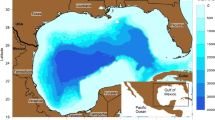Abstract
Numerical modeling is an important tool to study and predict the transport of oil spills. However, the accuracy of numerical models is not always good enough to provide reliable information for oil spill transport. It is necessary to analyze and identify major error sources for the models. A case study was conducted to analyze error sources of a three-dimensional oil spill model that was used operationally for oil spill forecasting in the National Marine Environmental Forecasting Center (NMEFC), the State Oceanic Administration, China. On June 4, 2011, oil from sea bed spilled into seawater in Penglai 19-3 region, the largest offshore oil field of China, and polluted an area of thousands of square kilometers in the Bohai Sea. Satellite remote sensing images were collected to locate oil slicks. By performing a series of model sensitivity experiments with different wind and current forcings and comparing the model results with the satellite images, it was identified that the major errors of the long-term simulation for oil spill transport were from the wind fields, and the wind-induced surface currents. An inverse model was developed to estimate the temporal variability of emission intensity at the oil spill source, which revealed the importance of the accuracy in oil spill source emission time function.
Similar content being viewed by others
References
Ana J Abascal, Sonia Castanedo, Raul Medina, et al. 2010. Analysis of the reliability of a statistical oil spill response model. Marine Pollution Bulletin, 60: 2099–2110
Bennett J R, Clites A H. 1987. Accuracy of trajectory calculation in a finite-difference circulation model. Journal of Computational Physics, 68: 272–282
Delvigne G A L, Hulsen L J M. 1994. Simplified laboratory measurements of oil dispersion coefficient application in computations of natural oil dispersion. In: Proceedings of the 17th Arctic and Marine Oil Spill Program (AMOP Technical Seminar. Environment Canada. 173–187
Delvigne G A L, Sweeney C E. 1988. Natural dispersion of oil. Oil and Chemical Pollution, 4: 281–310
Dong Haijun. 2009. Application of wind-driven current calculation in return period in offshore. Port Engineering Technology, 186: 1–3
Elliott A J. 2004. A probabilistic description of the wind over Liverpool Bay with application to oil spill simulations. Estuarine Coastal and Shelf Science, 61: 569–581
Elliot A J, Hurford N, Penn C J. 1986. Shear diffusion and the spreading of oil slicks. Marine Pollution Bulletin, 17: 308–313
Elliott A J, Jones B. 2000. The need for operational forecasting during oil spill response. Marine Pollution Bulletin, 40(2): 110–121
Huang J. 1983. A review of the state-of-the-art of oil spill fate/behavior models. In: Proceeding 1983 Oil Spill Conference. Washington, DC: American Petroleum Institute, 313–323
Ichiye Takashi. 1967. Upper ocean boundary-layer flow determined by dye diffusion. The Physics of Fluids, (Suppl): 270–277
James M Price, Walter R Johnson, Ji Zhen-Gang, et al. 2004. Sensitivity testing for improved efficiency of a statistical oil-spill risk analysis model. Environmental Modelling & Software, 19: 671–679
Jorda G, Comerma E, Bolaños R, et al. 2007. Impact of forcing errors in the CAMCAT oil spill forecasting system: a sensitivity study. Journal of Marine Systems, 65: 134–157
Liu Qinzheng, Zhang Cunzhi, Liu Yu, et al. 2005. On the oil-spill forecast systemin the Bohai Sea. Marine Forecasts, 22(suppl): 70–76
Liu Qinzheng, Zhang Jianhua, Liu Yu, et al. 2005a. Numerical forecast for the 3-dimensional sea temperature and current in the Bohai Sea. Marine Forecasts, 22(suppl): 27–34
Liu Qinzheng, Zhang Jianhua, Liu Yu, et al. 2005b. The numerical prediction model developed of three-dimensional currents and temperatures. Technical Report.
Marianoa A J, Kourafalou V H, Srinivasan A, et al. 2011. On the modeling of the 2010 Gulf of Mexico oil spill. Dynamics of Atmospheres and Oceans, 52: 322–340
Matsumoto K, Takanezawa T, Ooe M. 2000. Ocean tide models developed by assimilating TOPEX/POSEIDON altimeter data into hydrodynamical model: a global model and a regional model around Japan. Journal of Oceanography, 56: 567–581
Neumann G, Pierson Jr W. 1966. Principles of Physical Oceanography. Englewood Cliffs, NJ: Prentice-Hall Inc, 196–420
Reinaldo Garc-Ia-Mart-Inez, Henry Flores-Tovar. 1999. Computer modeling of oil spill trajectories with a high accuracy method. Spill Science & Technology Bulletin, 5(5/6): 323–330
Sebastião P, Guedes S C. 2006. Uncertainty in predictions of oil spill trajectories in a coastal zone. Journal of Marine Systems, 63: 257–269
Sebastião P, Guedes S C. 2007. Uncertainty in predictions of oil spill trajectories in open sea. Ocean Engineering, 34: 576–584
William J LEHR, Simecek-Beatty Debra. 2000. The relation of Langmuir circulation processes to the standard oil spill spreading, dispersion, and transport algorithms. Spill Science & Technology Bulletin, 6(3/4): 247–253
Zhang Cunzhi. 2006. Oil spill emergency forecasting system in Qinhuang Dao. Technical Report
Author information
Authors and Affiliations
Corresponding author
Additional information
Foundation item: This work was supported by Marine Industry Scientific Research Special Funds for Public Welfare Project “The development and application of fine-scale high precision comprehensive forecast system on the key protection coastal area”, under contact No. 201305031; and “The modular construction and application of marine forecasting operational system”, under contact No. 201205017.
Rights and permissions
About this article
Cite this article
Li, Y., Zhu, J., Wang, H. et al. The error source analysis of oil spill transport modeling: a case study. Acta Oceanol. Sin. 32, 41–47 (2013). https://doi.org/10.1007/s13131-013-0364-7
Received:
Accepted:
Published:
Issue Date:
DOI: https://doi.org/10.1007/s13131-013-0364-7




